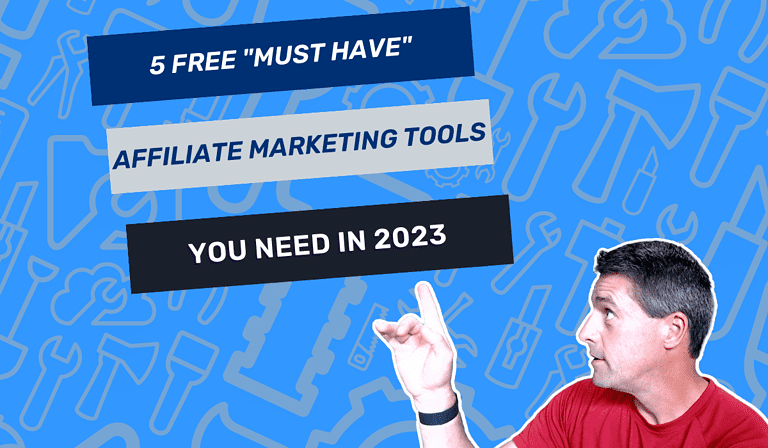Introduction
Are you interested in earning passive income while working from the comfort of your own home?
Affiliate marketing may be the perfect solution for you. This powerful marketing strategy allows individuals and businesses to earn a commission by promoting other companies’ products or services.
In this comprehensive guide, we’ll walk you through the steps of how to start affiliate marketing and share some valuable tips to ensure your success. Let’s dive in!

1. Choose Your Niche
Selecting the right niche is crucial for your affiliate marketing success, as it will lay the foundation for all of your future efforts. A well-chosen niche will enable you to create content that resonates with your target audience and promote products or services that are relevant to their needs. To help you choose the perfect niche, follow these steps:
- Identify your interests and passions: Your niche should be something you are genuinely interested in or passionate about. This will make it easier for you to create engaging content and maintain your motivation over time. Make a list of your hobbies, interests, and areas of expertise to identify potential niches.
- Research market demand: Once you have a list of potential niches, determine if there is sufficient market demand for the products or services you would like to promote. You can use tools like Google Trends and Keyword Planner to analyze search volume and trends for your niche ideas.
- Assess the competition: While some competition is expected, entering an overly saturated market can make it challenging to succeed in affiliate marketing. Use tools like SEMrush or Ahrefs to analyze the competitiveness of your potential niche. Look for niches with moderate competition, which often signal untapped opportunities.
- Evaluate profitability: Not all niches are equally profitable. Some may offer higher commission rates, while others may have a larger volume of potential customers. Research the affiliate programs available in your chosen niche and assess the potential return on investment. Also, consider the average price point of products in your niche to ensure it aligns with your income goals.
- Test your niche: Before fully committing to a niche, test your idea by creating some initial content and assessing the response from your target audience. This can help you identify potential challenges or opportunities for improvement before investing more time and resources into your chosen niche.
By carefully considering these factors and conducting thorough research, you can confidently choose a niche that aligns with your interests, offers growth potential, and sets you up for success as you figure out how to start affiliate marketing the right way!

2. Build a Platform
Creating a solid platform is essential for promoting your affiliate products or services effectively. Your platform is where you’ll share content and engage with your audience, ultimately driving them to make purchases through your affiliate links. Here are some key steps to show you how start a website for affiliate marketing:
- Choose your platform type: There are several options for building your affiliate marketing platform, including a website, blog, YouTube channel, podcast, or social media account. Determine which platform best suits your skills, interests, and audience preferences. A self-hosted WordPress website is a popular choice for beginners, as it provides flexibility and ease of use.
- Select a domain name: If you’re creating a website or blog, choose a domain name that reflects your niche and is easy to remember. Use a domain registrar like GoDaddy or Namecheap to check the availability of your desired domain and register it.
- Choose a web hosting provider: Web hosting is a service that allows you to store your website files and make them accessible to visitors. Some popular web hosting providers include Bluehost, SiteGround, and HostGator. Research and compare hosting plans to find one that meets your needs and budget.
- Design and optimize your platform: Regardless of the platform type you choose, aim for a clean, user-friendly design that aligns with your brand and makes it easy for visitors to navigate your content. Optimize your platform for SEO by using targeted keywords, creating high-quality content, and utilizing internal and external linking strategies.
- Create a content plan: Plan your content strategy by deciding on the types of content you’ll create, such as blog posts, product reviews, tutorials, or videos. Establish a posting schedule that allows you to consistently provide value to your audience while managing your workload.
- Build an email list: Email marketing is a powerful tool for promoting your affiliate products and nurturing relationships with your audience. Use an email marketing service like Mailchimp, ConvertKit or ActiveCampaign to create sign-up forms, manage your subscriber list, and send targeted email campaigns.
- Engage with your audience: Interact with your audience through comments, social media, or email to build trust and establish yourself as an authority in your niche. Respond to questions, provide helpful information, and ask for feedback to improve your content and better serve your audience.
By investing time and effort into building a strong platform, you’ll create a solid foundation as you learn how to start your affiliate marketing business and allows you to effectively promote products or services and generate income.

3. Sign up for Affiliate Programs
Joining the right affiliate programs is crucial for promoting products or services that resonate with your audience and generate income. Here are some key steps and tips for finding and joining the best affiliate programs for your niche:
- Research available affiliate programs: Start by researching various affiliate networks and programs that offer products or services within your niche. Some popular affiliate networks include Amazon Associates, ShareASale, ClickBank, and CJ Affiliate. Also, explore individual companies or brands within your niche that may offer their own affiliate programs.
- Evaluate commission structures: Different affiliate programs offer varying commission rates and payment structures. Some pay a flat fee per sale, while others offer a percentage of the sale amount. Consider the commission rates, payment frequency, and minimum payout thresholds when selecting an affiliate program.
- Check the program’s reputation: Before joining an affiliate program, research its reputation and track record. Read reviews from other affiliates and check for any red flags, such as late payments or poor customer service. Select programs that have a proven history of success and positive feedback from affiliates.
- Consider cookie duration: Cookie duration refers to the length of time a visitor’s activity is tracked after clicking your affiliate link. The longer the cookie duration, the more likely you are to receive a commission if the visitor makes a purchase within that time frame. Look for affiliate programs with longer cookie durations to maximize your earning potential.
- Examine promotional materials: Assess the quality and variety of promotional materials provided by the affiliate program, such as banners, product images, and sales copy. Having access to high-quality materials will make it easier for you to promote the products or services effectively.
- Apply to affiliate programs: Once you’ve identified suitable affiliate programs, submit your applications. Be prepared to provide information about your platform, audience, and promotional strategies. Some programs may require approval, while others offer instant access to affiliate links.
- Organize your affiliate links: After joining affiliate programs, you’ll receive unique affiliate links to use in your content. Keep track of your links and associated programs using a spreadsheet or a dedicated affiliate marketing management tool like Affilimate or Geniuslink.
By carefully selecting and joining the right affiliate programs, you’ll be able to promote products or services that align with your audience’s needs and interests, ultimately leading to higher conversion rates and greater income potential.

4. Create Engaging Content
Producing high-quality, engaging content is essential for capturing your audience’s attention, establishing trust, and driving affiliate sales. Follow these steps and tips to create compelling content for your affiliate marketing platform:
- Understand your audience: Before creating content, research and understand your target audience’s needs, preferences, and pain points. Knowing your audience helps you craft content that resonates with them and effectively addresses their concerns.
- Create a content mix: Develop a variety of content types to keep your audience engaged and interested. Consider blog posts, product reviews, how-to guides, tutorials, videos, podcasts, or infographics that are relevant to your niche and showcase your affiliate products or services.
- Focus on value: Provide value to your audience by offering actionable tips, in-depth information, and honest opinions. Aim to educate, entertain, or inspire your readers, making sure your content is useful and engaging.
- Incorporate storytelling: Use storytelling to make your content more relatable and memorable. Share personal experiences, case studies, or success stories that demonstrate the benefits of the affiliate products or services you’re promoting.
- Optimize for SEO: Implement SEO best practices to increase your content’s visibility in search engine results. Conduct keyword research, use relevant keywords in your headings and body text, create internal and external links, and optimize images with descriptive alt tags.
- Use visuals: Incorporate high-quality visuals, such as images, videos, or infographics, to make your content more appealing and easier to digest. Visuals can also help illustrate key points, showcase product features, or provide step-by-step instructions.
- Maintain consistency: Establish a consistent voice, style, and posting schedule to build trust and rapport with your audience. Consistency helps reinforce your brand identity and makes it easier for readers to recognize and engage with your content.
- Promote your content: Share your content across multiple channels, such as social media, email newsletters, or online communities, to increase its visibility and drive traffic to your platform. Engage with your audience by responding to comments, answering questions, and encouraging feedback.
- Monitor performance: Track your content’s performance using analytics tools like Google Analytics or social media insights. Assess metrics such as page views, engagement rates, and conversion rates to identify areas for improvement and optimize your content strategy.
By focusing on creating engaging, valuable content that appeals to your target audience, you’ll establish yourself as an authority in your niche, build trust with your readers, and increase the likelihood of generating affiliate sales.

5. Drive Traffic to Your Platform
Generating a steady stream of targeted traffic to your platform is essential for increasing affiliate sales and growing your online presence. Use these strategies to drive traffic to your affiliate marketing platform:
- Optimize for SEO: Implement on-page and off-page SEO techniques to improve your platform’s search engine rankings. Focus on creating high-quality, keyword-rich content, optimizing meta tags, and building authoritative backlinks to enhance your search engine visibility.
- Leverage social media: Use social media platforms such as Facebook, Twitter, Instagram, LinkedIn, and Pinterest to share your content, engage with your audience, and drive traffic back to your platform. Customize your content for each platform and participate in relevant online communities to reach a larger audience.
- Guest posting: Write guest posts for reputable blogs or websites within your niche. This not only exposes your content to a broader audience but also helps you build backlinks and authority within your industry. Be sure to include a link back to your platform in your author bio or within the content when allowed.
- Collaborate with influencers: Partner with influencers or other content creators within your niche to expand your reach and drive more traffic to your platform. Collaborations can take the form of guest appearances, interviews, or product reviews. Leverage each other’s audiences to mutually grow your online presence.
- Email marketing: Build an email list and use it to share your latest content, promote affiliate offers, and engage with your subscribers. A well-crafted email campaign can drive significant traffic to your platform and result in higher conversion rates. Tools like ActiveCampaign, GetResponse and AWeber can help automate this task.
- Paid advertising: Invest in paid advertising on platforms like Google Ads, Facebook Ads, or Instagram Ads to drive targeted traffic to your platform. Test various ad formats and targeting options to find the most effective campaigns for your niche and budget.
- Content syndication: Distribute your content on content syndication platforms or partner with other websites to republish your articles, widening your reach and attracting new visitors to your platform.
- Utilize forums and online communities: Participate in relevant online forums, Q&A websites like Quora, and niche-specific communities. Share your expertise, answer questions, and include links to your platform’s content when appropriate. Be genuine and helpful to establish credibility and build trust with potential visitors.
- Analyze and optimize: Use analytics tools such as Google Analytics to monitor your traffic sources and identify which strategies are most effective. Continuously refine and optimize your traffic generation efforts to attract a larger, more targeted audience.
By implementing these strategies and consistently promoting your platform, you’ll attract more visitors, boost your affiliate sales, and grow your online presence in your niche.

6. Analyze and Optimize Your Performance
Regularly analyzing and optimizing your affiliate marketing performance is essential for maximizing your earning potential and ensuring the long-term success of your business. Follow these steps to monitor, analyze, and improve your performance:
- Set up tracking tools: Implement tracking tools, such as Google Analytics, affiliate network dashboards, and third-party tracking software like Voluum or Affilimate, to collect data on your platform’s performance, traffic sources, and conversions.
- Establish key performance indicators (KPIs): Identify the most important metrics for your affiliate marketing business, such as conversion rates, click-through rates, average order value, and revenue per visitor. Establishing KPIs helps you focus on the most critical aspects of your performance and set realistic goals for improvement.
- Monitor your performance: Regularly review your performance data to identify trends, areas of success, and areas that require improvement. Analyze your traffic sources, audience demographics, and user behavior to gain insights into your audience’s preferences and interests.
- Optimize your content: Use your performance data to identify content that resonates with your audience and drives conversions. Focus on creating more of this type of content and updating underperforming content to better align with your audience’s needs and preferences.
- A/B testing: Conduct A/B tests to compare different versions of your content, promotional materials, or platform design. Test various elements, such as headlines, calls-to-action, images, or layouts, to determine which combinations yield the best results and drive higher conversions.
- Refine your promotional strategies: Analyze the effectiveness of your promotional efforts, such as email campaigns, social media posts, or paid advertising. Identify successful strategies and optimize underperforming campaigns to improve your reach, engagement, and conversions.
- Adjust your affiliate partnerships: Regularly assess the performance of your affiliate programs and partnerships. If certain programs are not generating the expected results, consider testing alternative programs or focusing on more profitable partnerships.
- Engage with your audience: Solicit feedback from your audience to better understand their needs, preferences, and concerns. Use this information to refine your content, promotional strategies, and platform design to create a more enjoyable and valuable experience for your visitors.
- Set and track goals: Establish measurable goals for your affiliate marketing business based on your KPIs and track your progress over time. Regularly reviewing your goals helps you stay focused, motivated, and accountable for your performance.
By consistently analyzing and optimizing your affiliate marketing performance, you’ll identify opportunities for growth, improve your audience engagement, and ultimately increase your revenue and achieve greater success in your niche.
Conclusion
Affiliate marketing is an excellent opportunity for individuals and businesses to generate passive income while promoting products or services they’re passionate about. By following the steps outlined in this guide, you’ll be well on your way to learning how to start affiliate marketing the right way.
Remember to choose a niche, build a platform, sign up for affiliate programs, create engaging content, drive traffic, and analyze your performance to optimize your success. With dedication, persistence, and a focus on providing value to your audience, you can achieve great success in the world of affiliate marketing.
Frequently Asked Questions
Below are the 10 most frequently asked questions about how to start affiliate marketing, along with their answers.
1. How much money can I make with affiliate marketing?
The income potential for affiliate marketing varies greatly depending on factors such as your niche, the affiliate programs you join, the quality of your content, and your marketing efforts. Some affiliates earn a few hundred dollars per month, while others make thousands or even millions annually. With dedication and the right strategies, you can create a significant income stream through affiliate marketing.
2. How long does it take to start making money with affiliate marketing?
It can take anywhere from a few weeks to several months or even years to start earning a consistent income from affiliate marketing. The timeline depends on your experience, the quality of your content, your marketing efforts, and the competitiveness of your niche. Patience and persistence are crucial for success in affiliate marketing.
3. Do I need any specific skills to become an affiliate marketer?
While no specific skills are required to learn how to start affiliate marketing, having some basic knowledge of digital marketing, SEO, and content creation will give you an advantage. It’s also essential to be motivated, adaptable, and willing to learn new strategies and techniques to grow your business.
4. How do I find the right affiliate products or services to promote?
To find the right affiliate products or services, consider your niche, your audience’s needs, and the reputation of the affiliate program. Research different affiliate networks and programs, read reviews, and choose products or services that align with your audience’s interests and solve their problems.
5. Can I join multiple affiliate programs at once?
Yes, you can join multiple affiliate programs and promote various products or services on your platform. However, it’s essential to avoid spreading yourself too thin and maintain a focus on providing value to your audience. Choose affiliate programs that complement each other and fit within your niche.
6. How do I generate traffic for my affiliate marketing website?
To generate traffic for your affiliate marketing website, focus on both organic and paid traffic strategies. Organic traffic includes optimizing your content for SEO, building quality backlinks, and promoting your content on social media. Paid traffic involves using advertising platforms like Google AdWords or social media ads to target your specific audience.
7. What is the best way to include affiliate links in my content?
The best way to include affiliate links in your content is to incorporate them naturally and contextually. Focus on providing value to your audience and recommend products or services that genuinely solve their problems or meet their needs. Always disclose your affiliate relationship to maintain transparency and trust with your audience.
8. Can I do affiliate marketing without a website?
Yes, you can do affiliate marketing without a website by leveraging social media platforms, email marketing, or other content-sharing platforms like YouTube. However, having a website or blog provides you with more control and flexibility, making it easier to optimize your content for SEO and build your online presence.
9. How do I choose the right niche for my affiliate marketing business?
To choose the right niche, consider your interests, passions, and expertise. Look for niches with a balance of high demand and low competition, and conduct keyword research to identify popular search terms. Select a niche that aligns with your knowledge and has growth potential.
10. How can I stay updated on affiliate marketing trends and strategies?
To stay updated on affiliate marketing trends and strategies, follow industry blogs, attend webinars and conferences, and join online communities and forums. Continuously learning and adapting to new trends and techniques will help you stay competitive in the ever-evolving world of affiliate marketing.
Do you have further questions? Don’t hesitate to use the contact form to get in touch.

